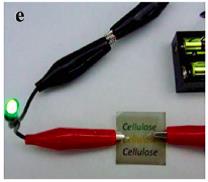
The outside front cover features the paper Energy applications of ionic liquids by Douglas R. MacFarlane, Naoki Tachikawa, Maria Forsyth, Jennifer M. Pringle, Patrick C. Howlett, Gloria D. Elliott, James H. Davis, Masayoshi Watanabe, Patrice Simon and C. Austen Angell.
Constructing ionic highway in alkaline polymer electrolytes is the paper highlighted on the inside front cover by Jing Pan, Chen Chen, Yao Li, Lei Wang, Lisheng Tan, Guangwei Li, Xun Tang, Li Xiao, Juntao Lu and Lin Zhuang.
Issue 11 contains a number of excellent Opinion, Analysis, Review, Minireview and Perspective articles:
Electrochemical energy storage in a sustainable modern society
John B. Goodenough
Reflections on the topic of solar fuels
John Meurig Thomas
The renaissance of energy innovation
Jim Skea
Piezoelectric and ferroelectric materials and structures for energy harvesting applications
C. R. Bowen, H. A. Kim, P. M. Weaver and S. Dunn
Physics and chemistry of CdTe/CdS thin film heterojunction photovoltaic devices: fundamental and critical aspects
S. Girish Kumar and K. S. R. Koteswara Rao
Upgrading of lignin-derived bio-oils by catalytic hydrodeoxygenation
Majid Saidi, Fereshteh Samimi, Dornaz Karimipourfard, Tarit Nimmanwudipong, Bruce C. Gates and Mohammad Reza Rahimpour
Carbon capture and storage update
Matthew E. Boot-Handford, Juan C. Abanades, Edward J. Anthony, Martin J. Blunt, Stefano Brandani, Niall Mac Dowell, José R. Fernández, Maria-Chiara Ferrari, Robert Gross, Jason P. Hallett, R. Stuart Haszeldine, 
Energetic I–III–VI2 and I2–II–IV–VI4 nanocrystals: synthesis, photovoltaic and thermoelectric applications
Feng-Jia Fan, Liang Wu and Shu-Hong Yu
Lithium ion battery applications of molybdenum disulfide (MoS2) nanocomposites
Tyler Stephenson, Zhi Li, Brian Olsen and David Mitlin
Energy applications of ionic liquids
Douglas R. MacFarlane, Naoki Tachikawa, Maria Forsyth, Jennifer M. Pringle, Patrick C. Howlett, Gloria D. Elliott, James H. Davis, Masayoshi Watanabe, Patrice Simon and C. Austen Angell
The panoscopic approach to high performance thermoelectrics
Li-Dong Zhao, Vinayak P. Dravid and Mercouri G. Kanatzidis
Transparent paper: fabrications, properties, and device applications
Hongli Zhu, Zhiqiang Fang, Colin Preston, Yuanyuan Li and Liangbing Hu



















